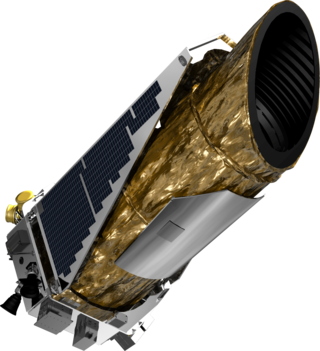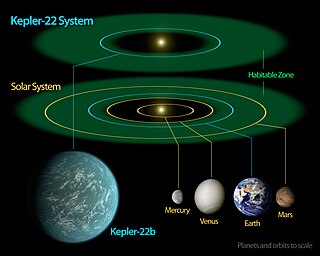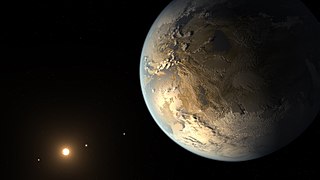Related Research Articles

An exoplanet or extrasolar planet is a planet outside the Solar System. The first possible evidence of an exoplanet was noted in 1917 but was not then recognized as such. The first confirmation of the detection occurred in 1992. A different planet, first detected in 1988, was confirmed in 2003. As of 1 May 2024, there are 5,662 confirmed exoplanets in 4,169 planetary systems, with 896 systems having more than one planet. The James Webb Space Telescope (JWST) is expected to discover more exoplanets, and to give more insight into their traits, such as their composition, environmental conditions, and potential for life.

The Kepler space telescope is a defunct space telescope launched by NASA in 2009 to discover Earth-sized planets orbiting other stars. Named after astronomer Johannes Kepler, the spacecraft was launched into an Earth-trailing heliocentric orbit. The principal investigator was William J. Borucki. After nine and a half years of operation, the telescope's reaction control system fuel was depleted, and NASA announced its retirement on October 30, 2018.

In astronomy and astrobiology, the habitable zone (HZ), or more precisely the circumstellar habitable zone (CHZ), is the range of orbits around a star within which a planetary surface can support liquid water given sufficient atmospheric pressure. The bounds of the HZ are based on Earth's position in the Solar System and the amount of radiant energy it receives from the Sun. Due to the importance of liquid water to Earth's biosphere, the nature of the HZ and the objects within it may be instrumental in determining the scope and distribution of planets capable of supporting Earth-like extraterrestrial life and intelligence.

A Super-Earth is a type of exoplanet with a mass higher than Earth's, but substantially below those of the Solar System's ice giants, Uranus and Neptune, which are 14.5 and 17 times Earth's, respectively. The term "super-Earth" refers only to the mass of the planet, and so does not imply anything about the surface conditions or habitability. The alternative term "gas dwarfs" may be more accurate for those at the higher end of the mass scale, although "mini-Neptunes" is a more common term.

An exoplanet is a planet located outside the Solar System. The first evidence of an exoplanet was noted as early as 1917, but was not recognized as such until 2016; no planet discovery has yet come from that evidence. What turned out to be the first detection of an exoplanet was published among a list of possible candidates in 1988, though not confirmed until 2003. The first confirmed detection came in 1992, with the discovery of terrestrial-mass planets orbiting the pulsar PSR B1257+12. The first confirmation of an exoplanet orbiting a main-sequence star was made in 1995, when a giant planet was found in a four-day orbit around the nearby star 51 Pegasi. Some exoplanets have been imaged directly by telescopes, but the vast majority have been detected through indirect methods, such as the transit method and the radial-velocity method. As of 1 May 2024, there are 5,662 confirmed exoplanets in 4,169 planetary systems, with 896 systems having more than one planet. This is a list of the most notable discoveries.

Kepler-22b is an exoplanet orbiting within the habitable zone of the Sun-like star Kepler-22. It is located about 640 light-years from Earth in the constellation of Cygnus. It was discovered by NASA's Kepler Space Telescope in December 2011 and was the first known transiting planet to orbit within the habitable zone of a Sun-like star, where liquid water could exist on the planet's surface. Kepler-22 is too dim to be seen with the naked eye.
Kepler-61b is a super-Earth exoplanet orbiting within parts of the habitable zone of the K-type main-sequence star Kepler-61. It is located about 1,100 light-years from Earth in the constellation of Cygnus. It was discovered in 2013 using the transit method, in which the dimming effect that a planet causes as it crosses in front of its star is measured, by NASA's Kepler spacecraft.

Kepler-186f is an Earth-sized exoplanet orbiting within the habitable zone of the red dwarf star Kepler-186, the outermost of five such planets discovered around the star by NASA's Kepler spacecraft. It is located about 580 light-years from Earth in the constellation of Cygnus.

Kepler-438b is a confirmed near-Earth-sized exoplanet. It is likely rocky. It orbits on the inner edge of the habitable zone of a red dwarf, Kepler-438, about 472.9 light-years from Earth in the constellation Lyra. It receives 1.4 times our solar flux. The planet was discovered by NASA's Kepler spacecraft using the transit method, in which the dimming effect that a planet causes as it crosses in front of its star is measured. NASA announced the confirmation of the exoplanet on 6 January 2015.

Kepler-442b is a confirmed near-Earth-sized exoplanet, likely rocky, orbiting within the habitable zone of the K-type main-sequence star Kepler-442, about 1,206 light-years (370 pc) from Earth in the constellation of Lyra.

K2-3d, also known as EPIC 201367065 d, is a confirmed exoplanet of probable mini-Neptune type orbiting the red dwarf star K2-3, and the outermost of three such planets discovered in the system. It is located 143 light-years away from Earth in the constellation of Leo. The exoplanet was found by using the transit method, in which the dimming effect that a planet causes as it crosses in front of its star is measured. It was the first planet in the Kepler "Second Light" mission to receive the letter "d" designation for a planet. Its discovery was announced in January 2015.
Kepler-419c is a super-Jupiter exoplanet orbiting within the habitable zone of the star Kepler-419, the outermost of two such planets discovered by NASA's Kepler spacecraft. It is located about 3,400 light-years from Earth in the constellation Cygnus. The exoplanet was found by using the transit timing variation method, in which the variations of transit data from an exoplanet are studied to reveal a more distant companion.

K2-72e (also known by its EPIC designation EPIC 206209135.04), is a confirmed exoplanet, likely rocky, orbiting within the habitable zone of the red dwarf star K2-72, the outermost of four such planets discovered in the system by NASA's Kepler spacecraft on its "Second Light" mission. It is located about 217.1 light-years (66.56 parsecs, or nearly 2.0538×1015 km) away from Earth in the constellation of Aquarius. The exoplanet was found by using the transit method, in which the dimming effect that a planet causes as it crosses in front of its star is measured.
Kepler-1652b is a super-Earth exoplanet, orbiting within the habitable zone of the red dwarf Kepler-1652 about 822 light-years away in the Cygnus constellation. Discovered by NASA's Kepler spacecraft, Kepler-1652b was first announced as a candidate in 2013, but wasn't validated until four years later in 2017. It is a potential super-Earth with 160% Earth's radius. The planet orbits well within the habitable zone of its system, the region where liquid water can exist on a planet's surface. The planet is an eyeball planet candidate.
K2-148b is a confirmed super-Earth, probably rocky, closely orbiting a small orange dwarf star. It is the innermost of three Super-Earths around the star K2-148, which is in a wide binary pair with the M0.5V red dwarf EPIC 220194953. K2-148b is the smallest planet of the system, at about a third larger than Earth, and could be terrestrial in nature. However, the three planets do not exhibit significant transit timing variations, implying that they could have relatively low masses. The planet was validated in early 2018 by Hirano et al. and is too hot for known life.

K2-288Bb is a super-Earth or mini-Neptune exoplanet orbiting in the habitable zone of K2-288B, a low-mass M-dwarf star in a binary star system in the constellation of Taurus about 226 light-years from Earth. It was discovered by citizen scientists while analysing data from the Kepler spacecraft's K2 mission, and was announced on 7 January 2019. K2-288 is the third transiting planet system identified by the Exoplanet Explorers program, after the six planets of K2-138 and the three planets of K2-233.

Kepler-1649c is an Earth-sized exoplanet, likely rocky, orbiting within the habitable zone of the red dwarf star Kepler-1649, the outermost planet of the planetary system discovered by Kepler’s space telescope. It is located about 301 light-years (92 pc) away from Earth, in the constellation of Cygnus.
K2-415b is an Earth-sized exoplanet located 72 light-years from Earth orbiting the red dwarf star K2-415.
References
- 1 2 "15 new planets confirmed around cool dwarf stars". Tokyo Tech News. March 12, 2018.
- ↑ "The Extrasolar Planet Encyclopaedia — K2-155 d". Extrasolar Planets Encyclopaedia . Retrieved 2024-04-29.
- 1 2 3 4 5 6 7 8 9 10 Hirano, Teruyuki; et al. (March 2018). "K2-155: A Bright Metal-poor M Dwarf with Three Transiting Super-Earths". The Astronomical Journal . 155 (3): 11. arXiv: 1801.06957 . Bibcode:2018AJ....155..124H. doi: 10.3847/1538-3881/aaaa6e . S2CID 73590567. 124.
- 1 2 "HEC: Exoplanets Calculator (K2-155d)". Planetary Habibility Laboratory. Archived from the original on 2017-08-24. Retrieved 2018-03-30.
- 1 2 3 4 5 6 7 8 9 Mack, Eric (March 13, 2018). "A super-Earth around a red star could be wet and wild". CNET .
- ↑ "K2-155 PLANET HOST OVERVIEW PAGE". NASA Exoplanet Archive.
- 1 2 3 4 Dovey, Dana (March 14, 2018). "Super Earth 200 Light-Years Away May Hold Ideal Temperatures For Liquid Water And Life". Newsweek .
- 1 2 "Confirmed Planet Overview Page: K2-155d". NASA Exoplanet Archive. 2018.
- ↑ "K2-155d". Exoplanet Data Explorer. 2018. Archived from the original on 2018-03-22. Retrieved 2018-03-21.
- ↑ Eylen, Vincent; Albrecht, Simon (May 11, 2015). "Eccentricity from transit photometry: small planets in Kepler multi-planet systems have low eccentricities". The Astrophysical Journal. 808 (2): 126. arXiv: 1505.02814 . Bibcode:2015ApJ...808..126V. doi:10.1088/0004-637X/808/2/126. S2CID 14405731.

